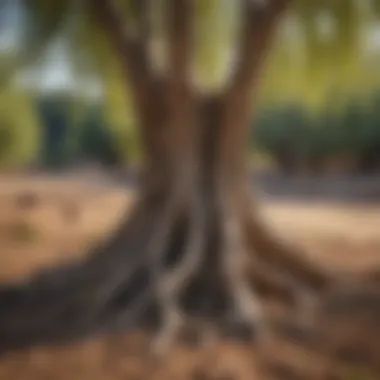Unveiling the Marvels of Willow Trees in the Utah Landscape


Plant Species Profile
Willow trees, popularly known for their graceful appearance and ecological significance, embody a captivating essence in the landscapes of Utah. Their slender branches and elongated leaves create a mesmerizing sight that sets them apart from other tree species in the region. The willow trees play a vital role in stabilizing riverbanks and wetland ecosystems due to their deep root systems and erosion-preventing qualities. Over the course of this article, we will delve into the various facets of these enchanting trees, shedding light on their uniqueness and contribution to Utah's natural environment.
Physical Characteristics and Appearance
Willow trees are characterized by their flexible branches, slender leaves, and overall elegant form. The bark of these trees is often smooth and may range in color from a pale gray to a light brown hue. The leaves are elongated with a rounded tip and a serrated edge, giving them a delicate and airy appearance. During the spring and summer months, willow trees burst into life with lush green foliage that sways gently in the breeze, creating a serene and tranquil atmosphere in their surroundings.
Natural Habitat and Distribution
Native to Utah, willow trees are predominantly found along riverbanks, streams, and wetland areas where their roots can access ample moisture. These trees thrive in moist soil conditions, often bordering bodies of water or areas with high water tables. Their presence is integral to maintaining the ecological balance of riparian habitats, providing habitat for various wildlife species and contributing to the overall biodiversity of the region.
Ecological Significance
Willow trees play a crucial role in stabilizing soil, preventing erosion, and creating shelter for numerous wildlife species. Their intricate root systems help bind the soil together, reducing the risk of landslides and preserving the integrity of riverbanks and wetland ecosystems. Furthermore, willow trees act as carbon sinks, absorbing carbon dioxide from the atmosphere and helping mitigate the impacts of climate change on a local scale. By exploring the ecological significance of willow trees, we gain a deeper appreciation for these majestic beings that form an integral part of Utah's natural heritage.
Introduction
Overview of Willow Trees
Willow trees hold a significant place in the diverse ecosystem of Utah, playing a crucial role in supporting the overall environmental balance of the region. Their presence enriches the landscapes with their distinct characteristics, offering shade, shelter, and sustenance to various wildlife species. Understanding the overview of willow trees is essential for appreciating their importance in the local ecology and the broader context of conservation efforts aimed at preserving these iconic trees.
Characteristics of Willow Trees
Leaf Structure
The leaf structure of willow trees is characterized by long and slender leaves that often exhibit a narrow shape. This unique feature enables willow trees to efficiently capture sunlight for photosynthesis, contributing to their robust growth and overall vitality. The flexibility of their leaves also allows them to sway gracefully with the wind, enhancing their aesthetic appeal while maximizing light absorption.
Bark Texture


The bark of willow trees generally displays a smooth texture, ranging in color from shades of grey to brown. This smooth bark not only provides protection against external elements but also serves as a distinguishing feature that sets willow trees apart from other species. The bark's resilience aids in regulating moisture levels within the tree, crucial for its health and longevity.
Root System
Willow trees are renowned for their extensive root systems, often reaching deep into the soil to access water and nutrients. This robust root structure plays a vital role in stabilizing the tree, preventing soil erosion, and promoting water retention in the surrounding ecosystem. Additionally, the intricate network of roots enhances the tree's resilience to adverse conditions, ensuring its survival in challenging environments.
Varieties of Willow Trees in Utah
Narrowleaf Willow
The narrowleaf willow species is characterized by its slender leaves and branches, giving it a graceful and delicate appearance. This variety of willow tree thrives in riparian habitats, such as wetlands and riverbanks, where its roots aid in preventing erosion and maintaining water quality. The narrowleaf willow's adaptability and aesthetic appeal make it a favored choice for landscaping projects focused on ecological restoration.
Sandbar Willow
Sandbar willow trees are commonly found along riverbanks and floodplains, where their dense root systems play a crucial role in stabilizing soil and regulating water levels. The sandbar willow's ability to withstand periodic flooding makes it a resilient species that contributes to the overall health of riparian ecosystems. Its rapid growth and capacity to form dense thickets provide valuable habitat for various wildlife species.
Black Willow
Black willow trees are known for their striking appearance, featuring dark, fissured bark and drooping branches that create a picturesque silhouette. This species thrives in moist environments, particularly near streams and marshy areas, where its roots help in soil stabilization and water filtration. The black willow's significance lies in its ability to enhance biodiversity within riparian zones, providing essential habitat for diverse flora and fauna.
Ecological Role of Willow Trees
Willow trees play a crucial role in the ecological balance of Utah's landscapes. These majestic trees contribute significantly to the ecosystem by providing essential benefits such as soil stabilization, water retention, and habitat for various wildlife species. Willow trees act as natural buffers along rivers and streams, preventing erosion and minimizing the impact of floods. Their extensive root systems help in anchoring soil, reducing sediment runoff, and maintaining water quality. Furthermore, these trees offer a habitat for a diverse range of flora and fauna, enhancing biodiversity within the region. Exploring the ecological role of willow trees unveils the intricate interconnectedness of nature and highlights the importance of preserving these vital components of the Utah ecosystem.
Water Resource Management
Riverbank Stabilization
Riverbank stabilization is a critical aspect of willow trees' ecological significance. By planting willow trees along riverbanks, the process of soil erosion is significantly reduced. Willow roots penetrate deep into the soil, holding it together and preventing sediments from washing away during heavy rains or floods. This natural stabilization method not only protects the integrity of riverbanks but also helps in maintaining water quality by reducing sedimentation and runoff. The flexibility and adaptability of willow trees make them a popular choice for riverbank stabilization projects, ensuring long-term sustainability and environmental resilience.


Flood Prevention
Flood prevention is another vital contribution of willow trees to water resource management. The dense root systems of willow trees effectively absorb large amounts of water, reducing the risk of flooding in low-lying areas. By planting willow trees strategically in flood-prone regions, the trees act as natural barriers, slowing down and absorbing excess water during periods of heavy rainfall. This natural flood mitigation approach not only safeguards human settlements and agricultural lands but also maintains the natural flow of rivers and streams. Willow trees' effectiveness in flood prevention showcases their invaluable role in enhancing the resilience of Utah's water resources.
Wildlife Habitat
Bird Species
Willow trees create a diverse and thriving habitat for numerous bird species in Utah. The flexible branches and abundant foliage provide excellent nesting sites and shelter for birds throughout the year. Bird species such as warblers, finches, and wrens find refuge in the dense canopy of willow trees, utilizing them for foraging, breeding, and protection. The presence of willow trees encourages avian biodiversity, attracting a plethora of bird species that contribute to the vibrant birdlife of Utah's ecosystem. Birdwatchers and nature enthusiasts flock to areas rich in willow trees to witness the dynamic array of avian species that call these trees home.
Mammals
Willow trees offer essential habitat and resources for various mammal species in Utah. Small mammals like squirrels, chipmunks, and rabbits utilize the protective cover of willow trees for nesting and foraging. Larger mammals such as deer and elk are also drawn to willow stands to browse on the nutritious leaves and twigs. The dense growth and intricate branching patterns of willow trees create safe havens for mammals to seek shelter and food. By supporting a diverse range of mammalian wildlife, willow trees contribute significantly to the rich biodiversity of Utah's natural environment. Observing the interactions between mammals and willow trees underscores the intricate ecological relationships that sustain the delicate balance of the region's wildlife.
CULTURAL SIGNIFICANCE
Willow trees hold profound cultural significance in Utah, revered for their symbolism and utility. The Native American perspectives on these majestic trees offer a glimpse into their rich cultural tapestry. The intertwining with mythology and medicinal properties portrays a deep connection between the humble willow and indigenous traditions. Mythological Connections within Native American lore often depict willow trees as symbols of resilience and adaptability, reflecting the values of the communities. This portrayal serves as a nod to the enduring spirit embodied by these trees, making them a poignant choice for exploration in this article. The Medicinal Use of willow trees further elevates their cultural importance, with various tribes utilizing different parts of the tree for healing purposes. This dual significance of willow trees in Native American culture underscores their sacred presence and lasting influence.
Native American Perspectives
Mythological Connections:
The integration of willow trees in Native American myths elucidates a deep-rooted reverence for nature's wisdom and resilience. These mythological ties often portray willows as symbols of adaptability and growth in the face of adversity. The inherent strength and flexibility of these trees mirror the values cherished by indigenous cultures, symbolizing endurance and spiritual depth. As a beneficial thematic choice for this article, Mythological Connections offer a window into the intricate relationship between nature and cultural narratives, emphasizing the timeless allure of willow trees in Native American traditions. The unique feature of these connections lies in their ability to bridge spiritual concepts with tangible natural elements, creating a rich tapestry of meaning and significance within Native American heritage.
Medicinal Use:
The medicinal properties of willow trees have been a cornerstone of Native American healing practices for generations. Utilizing different parts of the tree, such as the bark or leaves, tribes have concocted remedies for various ailments, emphasizing the tree's therapeutic value. The key characteristic of Medicinal Use lies in its holistic approach to healing, viewing the willow tree not just as a botanical resource but as a source of spiritual strength and vitality. This aspect's contribution to the overall discourse on willow trees showcases the symbiotic relationship between nature and culture, highlighting the profound wisdom embedded in indigenous medicinal practices. Despite occasional disadvantages, such as sustainability concerns, the Medicinal Use of willow trees remains a poignant reminder of the intimate bond between Native American communities and the natural world.
Artistic Inspiration


From literature to visual arts, willow trees have inspired countless artistic expressions, capturing their beauty and mystique in varied forms. Each artistic avenue offers a unique perspective on these iconic trees, weaving a tapestry of creativity and meaning that transcends cultural boundaries. Literature often portrays willow trees as symbols of grace and introspection, mirroring their serene presence in natural settings. The choice to feature Literature in this article provides a deeper understanding of the profound impact willow trees have on creative expressions, delving into the nuanced interpretations offered by writers and poets. The distinctive feature of Literature lies in its ability to evoke emotions and contemplation, immersing readers in the tranquil world of willow trees through metaphor and allegory.
Visual Arts serve as a powerful medium for capturing the ethereal beauty of willow trees, translating their organic forms into captivating visuals. The key characteristic of Visual Arts lies in its ability to evoke sensory experiences and evoke contemplation, offering viewers a vibrant portrayal of willow trees' essence. In the context of this article, Visual Arts emerge as a beneficial choice for exploring willow trees' cultural significance, enriching the narrative with evocative images and interpretations. Despite potential disadvantages, such as subjective interpretations, Visual Arts provide a visual gateway into the enchanting world of willow trees, bridging the gap between nature and artistic expression.
Conservation Efforts
Conservation efforts play a pivotal role in preserving the delicate balance of nature, especially when it comes to the majestic willow trees in Utah. These initiatives are crucial to safeguarding the habitats of various wildlife species that depend on willow trees for survival. Through strategic planning and active participation, conservation efforts aim to mitigate the threats that endanger the existence of these iconic trees, ensuring their presence for generations to come.
Challenges Facing Willow Trees
Habitat Loss
Habitat loss stands as a formidable challenge facing willow trees in Utah, primarily due to urbanization and agricultural expansion. The encroachment of human activities threatens the natural ecosystems where these trees thrive, leading to a decline in their population. The rapid destruction of wetlands and riparian areas further exacerbates the vulnerability of willow trees, highlighting the pressing need for immediate conservation actions.
Climate Change
Climate change poses a significant risk to the survival of willow trees in Utah, altering the local environment and disrupting traditional growth patterns. The increase in temperatures and shifts in precipitation levels impact the overall health of these trees, making them more susceptible to diseases and pests. Addressing climate change is paramount in ensuring the resilience of willow trees, as they play a vital role in maintaining ecological balance in the region.
Initiatives for Preservation
In response to these challenges, various initiatives for the preservation of willow trees have been introduced, focusing on sustainable practices and community engagement.
Riparian Restoration Projects
Riparian restoration projects aim to restore the degraded riparian zones where willow trees typically grow. By implementing revegetation techniques and erosion control measures, these projects help reestablish healthy habitats for willow trees, fostering biodiversity and enhancing ecosystem resilience.
Community Engagement
Community engagement plays a crucial role in the conservation of willow trees, as it raises awareness and promotes local stewardship. Collaborative efforts involving educational programs, tree planting initiatives, and citizen science projects empower communities to take an active role in protecting these iconic trees, ensuring their continued presence in the Utah landscape.
Where to See Willow Trees in Utah
Willow trees in Utah can be found in various locations across the state, adding to the natural beauty of the landscape. These trees are often sighted near water bodies such as rivers, lakes, and wetlands due to their preference for moist environments. One of the prime spots to observe willow trees in Utah is along the banks of the Green River, where their elegant branches sweep gracefully over the water's edge, creating a picturesque scene. Another enchanting location to encounter these trees is in the Uinta-Wasatch-Cache National Forest, where they thrive in the damp soils along streams and creeks. Hiking trails in Big Cottonwood Canyon also offer opportunities to witness these majestic trees up close, providing a serene and peaceful setting for nature enthusiasts and photographers alike.
When planning a visit to explore willow trees in Utah, it's essential to consider the seasonal changes that affect their appearance and surroundings. Springtime brings about lush green foliage and delicate blooms, enhancing the visual appeal of these trees. Summer unveils a vibrant canopy of leaves that provide ample shade and refuge for wildlife. Fall transforms the leaves into a myriad of golden hues, painting a spectacular display against the autumn landscape. Winter showcases the bare branches of the willow trees, offering a different perspective of their intricate structure against the snowy backdrop.
For those interested in a more guided experience, botanical gardens and nature reserves in Utah often feature curated displays of willow trees, showcasing different species and hybrids. These curated settings allow visitors to learn about the diverse characteristics of willow trees, including leaf shapes, bark textures, and growth patterns. Educational programs and guided tours offered at these locations provide valuable insight into the ecological importance of willow trees and their role in supporting local wildlife habitats. Additionally, botanical experts are usually on hand to answer questions and share fascinating facts about the cultural significance and conservation efforts related to willow trees in Utah. By visiting these designated sites, nature enthusiasts can deepen their appreciation for these iconic trees and contribute to their preservation and conservation for future generations.







